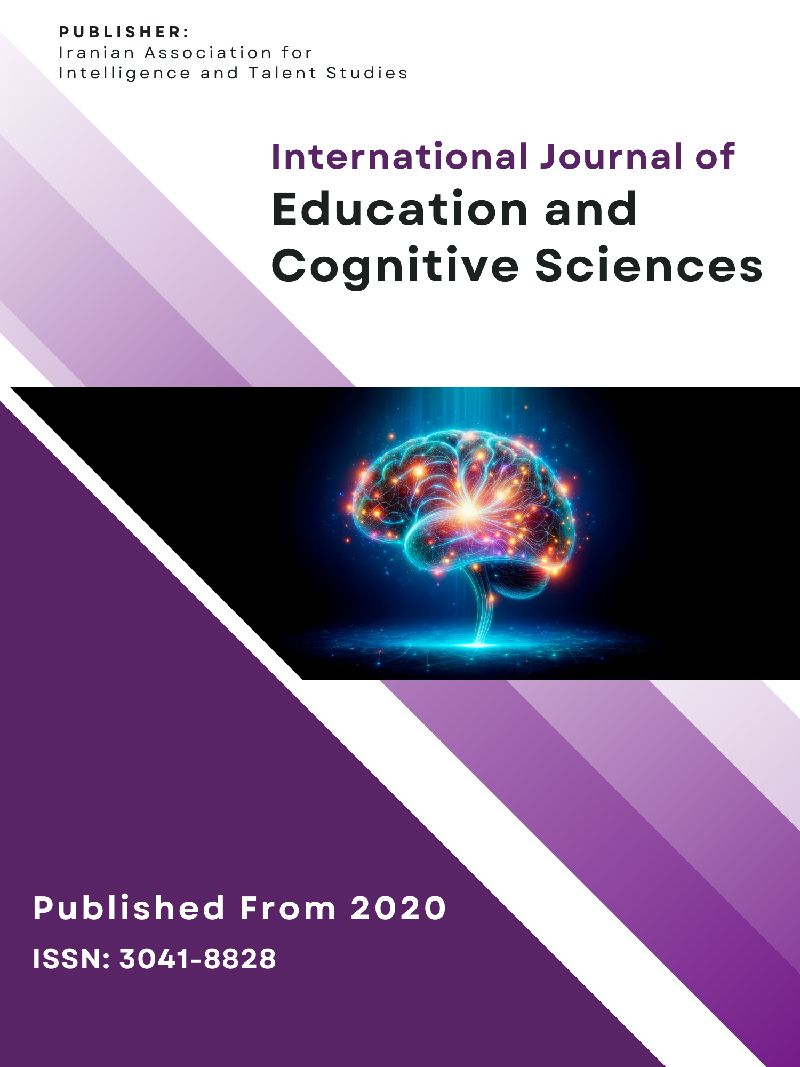Investigating the Relationship Between Psychological Capital and Attachment Styles with Risky Behaviors: The Mediating Role of Self-Compassion in Students
Keywords:
Risky behaviors, psychological capital, attachment styles, self-compassionAbstract
Purpose: The present study aimed to determine the relationship between risky behaviors based on psychological capital and attachment styles with the mediating role of self-compassion.
Methods and Materials: This study was applied in nature and employed a descriptive design in terms of data collection method (research design), and it used structural equation modeling (SEM) for data analysis. The statistical population consisted of all female students enrolled in lower secondary schools in Tehran during the 2023–2024 academic year. A total of 385 students were selected through multistage cluster random sampling. The instruments used in this study included the Risky Behavior Questionnaire by Zadehmohammadi et al. (2008), the Psychological Capital Questionnaire by Luthans et al. (2007), the Attachment Styles Questionnaire by Hazan and Shaver (1987), and the Self-Compassion Scale by Neff (2003). Data were analyzed using SPSS version 23 and LISREL version 8.8.
Findings: The results showed that psychological capital, secure attachment style, and self-compassion had a direct and significant negative effect on risky behaviors. Conversely, avoidant insecure attachment style and ambivalent insecure attachment style had a direct and significant positive effect on risky behaviors. The findings related to indirect effects indicated that the relationships between psychological capital and attachment styles with risky behaviors were significant through the mediating role of self-compassion (P < .01).
Conclusion: Given the study findings, it is essential to understand the elements that may influence adolescents’ tendency toward risky behaviors in order to design effective intervention strategies that can prevent many of these behaviors.
Downloads
References
Barahoyi, S., Najafi, M., & Tale'pasand, S. (2023). Predicting High-Risk Behaviors based on Positive Youth Development and Positive Psychological Capital in Adolescents. Scientific Quarterly Research on Addiction, 17(69), 245-270. https://doi.org/10.61186/etiadpajohi.17.69.245
Bi, X., & Jin, J. (2021). Psychological capital, college adaptation, and internet addiction: an analysis based on moderated mediation model. Frontiers in Psychiatry, 12, 712964. https://doi.org/10.3389/fpsyt.2021.712964
Cadely, H. S. E., Finnegan, V., Spears, E. C., & Kerpelman, J. L. (2020). Adolescents and sexual risk-taking: The interplay of constraining relationship beliefs, healthy sex attitudes, and romantic attachment insecurity. Journal of adolescence, 84, 136-148. https://doi.org/10.1016/j.adolescence.2020.08.010
Cannon, C., & Rucker, D. D. (2022). Motives underlying human agency: How self-efficacy versus self-enhancement affect consumer behavior. Current opinion in psychology, 46, 101335. https://doi.org/10.1016/j.copsyc.2022.101335
Chokan Sonbol, F. S., Rezaeian Faraji, H., & Abdollahi, A. (2023). The relationship between attachment styles and high-risk sexual behavior: Investigating the moderating role of birth order and sexual abuse history in childhood. Rooyesh-e-Ravanshenasi Journal (RRJ), 12(7), 31-40. https://frooyesh.ir/article-1-4459-en.html&sw=High-Risk+Sexual+Behavior
Chwyl, C., Chen, P., & Zaki, J. (2021). Beliefs about self-compassion: Implications for coping and self-improvement. Personality and Social Psychology Bulletin, 47(9), 1327-1342. https://doi.org/10.1177/0146167220965303
Craig, S. G., Sierra Hernandez, C., Moretti, M. M., & Pepler, D. J. (2021). The mediational effect of affect dysregulation on the association between attachment to parents and oppositional defiant disorder symptoms in adolescents. Child Psychiatry & Human Development, 52, 818-828. https://doi.org/10.1007/s10578-020-01059-5
Dabiri, S. (2022). The Role of Self-Control, Emotions, and Self-Compassion in the Prediction of Addiction Readiness. Scientific Quarterly Research on Addiction, 16(65), 311-332. https://doi.org/10.52547/etiadpajohi.16.65.311
Gonçalves, S., Vieira, A. I., Machado, B. C., & Bessa, C. (2024). Non-suicidal self-injury in Portuguese college students: relationship with emotion regulation, resilience and self-compassion. Current Psychology, 43(9), 7877-7886. https://doi.org/10.1007/s12144-023-04985-4
Gonsalves, K., & Hallett, K. (2021). What Is Your Attachment Style? Attachment Theory, Explained. mindbodygreen.
Huang, M., & Hou, J. (2023). Childhood maltreatment and suicide risk: The mediating role of self-compassion, mentalization, depression. Journal of affective disorders, 341, 52-61. https://doi.org/10.1016/j.jad.2023.08.112
Jia, X., Zhu, H., Sun, G., Meng, H., & Zhao, Y. (2021). Socioeconomic status and risk-taking behavior among Chinese adolescents: the mediating role of psychological capital and self-control. Frontiers in psychology, 12, 760968. https://doi.org/10.3389/fpsyg.2021.760968
Kim, H. M., & Miller, L. C. (2020). Are insecure attachment styles related to risky sexual behavior? A meta-analysis. Health Psychology, 39(1), 46. https://doi.org/10.1037/hea0000821
Kıran, B., & Cengiz, Ö. (2021). Risk taking behavior as predictors of self compassion in university students. Psycho-Educational Research Reviews, 10(3), 23-29. https://doi.org/10.52963/PERR_Biruni_V10.N3.02
Kumar, S. A., Jaffe, A. E., Brock, R. L., & DiLillo, D. (2022). Resilience to suicidal ideation among college sexual assault survivors: The protective role of optimism and gratitude in the context of posttraumatic stress. Psychological Trauma: Theory, Research, Practice, and Policy, 14(S1), S91. https://doi.org/10.1037/tra0001141
Mohammadzadeh, M., Awang, H., Jun, C. Y., Hashim, N. F., & Premkumar, A. (2020). Relationship between attachment styles and risk behavior (smoking and bullying) among secondary school students: an experience from Hulu Langat, Malaysia. Iranian Journal of Public Health, 49(10), 2006. https://doi.org/10.18502/ijph.v49i10.4708
Moladoost, A., Jabalameli, S., Sajjadieh-Khajouei, A., & Farzi, S. (2022). Structural Model of the Effect of Psychological Capital on Self-Care with Mediating Role of Self-Compassion in Patients with Heart Diseases. Journal of Health System Research, 18(1), 23-29. https://hsr.mui.ac.ir/article-1-1244-en.html
Moradimoghadam, H., & Delavarpour, M. (2023). Investigating Librarians' Psychological Capital Status and Its Relationship with Their Conflict Management Strategies. Library and Information Science Research, 13(1), 186-204. https://www.researchgate.net/publication/372394594_Investigating_Librarians%27_Psychological_Capital_Status_and_Its_Relationship_with_Their_Conflict_Management_Strategies
Motale, M., Hosseini, S. V., & Roshandel, A. (2024). Self-harm behaviours prediction based on frustration intolerance and self-compassion in adolescent girls. Iranian Journal of Psychiatric Nursing, 12(1), 30-39. https://ijpn.ir/browse.php?a_code=A-10-2336-1&sid=1&slc_lang=en
Neff, K. D. (2023). Self-compassion: Theory, method, research, and intervention. Annual review of psychology, 74(1), 193-218. https://doi.org/10.1146/annurev-psych-032420-031047
Noroozi, Y., & Janjani, P. (2023). Investigating the mediating role of difficulty in emotion regulation in the relationship between attachment styles and rumination in high-risk behaviors of adolescent girls. Journal of Arak University of Medical Sciences, 26(3), 41-46. https://jams.arakmu.ac.ir/browse.php?a_id=7535&sid=1&slc_lang=en&ftxt=0
Olson, A. E., Chow, S. M., Jones, D. E., & Shenk, C. E. (2023). Child maltreatment, parent-child relationship quality, and parental monitoring in relation to adolescent behavior problems: Disaggregating between and within person effects. Child abuse & neglect, 136, 106003. https://doi.org/10.1016/j.chiabu.2022.106003
Owino, W. O., & Asakhulu, N. M. (2021). Attachment styles and risky sexual behaviors in adolescents. Psychology. https://doi.org/10.33225/pec/21.79.928
Porzoor, P., & Hajipour, M. (2023). Predicting Mobile phone addictive behavior in students based on emotional self-regulation, self-compassion, and attachment styles to God. Journal of School Psychology and Institutions, 12(2), 45-58. https://jsp.uma.ac.ir/article_2438.html?lang=en
Poursaeid Esfahani, M., Sharifi, H., & Akrami, N. (2021). Predicting high-risk behavior based on self-differentiation and interpersonal problems in female students. Rooyesh-e-Ravanshenasi Journal (RRJ), 10(3), 55-64. https://frooyesh.ir/browse.php?a_id=2529&slc_lang=en&sid=1&printcase=1&hbnr=1&hmb=1
Saket, M. H., Davari, R., & Sharifi, H. P. (2023). The mediating role of perceived social support and differentiation in explaining structural relationships between psychological capital and psychological well-being of students. Journal of Counselling Excellence and Psychotherapy, 45, 14-27. https://sanad.iau.ir/en/Article/932130
Saladino, V., Fusco, A., Castellani, L., Calaresi, D., & Verrastro, V. (2024). Aggressive behavior among Italian justice-involved juveniles: The impact of attachment, discipline, and moral disengagement. Psychology, Crime & Law, 1-17. https://doi.org/10.1080/1068316X.2024.2303496
Salimi, F., Shahyad, S., Ghahvehchi-Hosseini, F., & Davari, R. (2023). Mediating the dimensions of self-compassion on attachment styles and high-risk behaviors of students: Identifying educational challenges. Education Strategies in Medical Sciences, 15(6), 622-629. https://edcbmj.ir/browse.php?a_id=2746&sid=1&slc_lang=en
Sefidrood, M., & Hobbi, M. B. (2023). The Role of Attachment Styles and Cognitive Emotion Regulation in Predicting the Tendency to High-Risk Behaviors in Adolescents. International Journal of Applied Behavioral Sciences, 10(1), 1-8. https://journals.sbmu.ac.ir/ijabs/article/view/34259
Sepahvand, A., Nader, M., & Zargham Hajebi, M. (2023). Model of Academic Engagement Based on Psychological Capital with the Mediating of Self-Determination. Psychological Achievements, 30(2), 59-80. https://psychac.scu.ac.ir/article_18553.html?lang=en
Seyed Khorasani, M. S., Rafiei-Honar, H., & Mirzahosseini, H. (2023). The Role of Perceived Parenting Style and Attachment Style in Adolescents' Psychological Well-Being with the Mediation of Self-Control: A Descriptive Study. Journal of Rafsanjan University of Medical Sciences, 22(7), 707-724. https://doi.org/10.61186/jrums.22.7.707
Sharei, A., Kasaeei Esfahani, A., & Salmani, A. (2025). The Effect of Mindfulness Therapy on Emotion Regulation, Cognitive Self-Awareness, and Tendency to High-Risk Behaviors in Orphaned and Poorly Monitored Adolescents: A Quasi-Experimental Study. Journal of Rafsanjan University of Medical Sciences, 23(9), 812-827. https://doi.org/10.61186/jrums.23.9.812
Tariq, N., & Gupta, V. (2023). High risk behaviors. StatPearls. https://www.ncbi.nlm.nih.gov/books/NBK560756/
Tucker, J. S., Rodriguez, A., Davis, J. P., & D'Amico, E. J. (2022). Cross-lagged associations of insecure attachment style, alcohol use, and sexual behavior during emerging adulthood. Archives of Sexual Behavior, 51(3), 1521-1530. https://doi.org/10.1007/s10508-021-02106-5
Wang, W., Mehmood, A., Li, P., Yang, Z., Niu, J., Chu, H., Qiao, Z., Qiu, X., Zhou, J., Yang, Y., & Yang, X. (2021). Perceived stress and smartphone addiction in medical college students: the mediating role of negative emotions and the moderating role of psychological capital. Frontiers in psychology, 12, 660234. https://doi.org/10.3389/fpsyg.2021.660234
Wilkins, N. J. (2023). School connectedness and risk behaviors and experiences among high school students-Youth Risk Behavior Survey, United States, 2021. MMWR supplements, 72. https://doi.org/10.15585/mmwr.su7201a2
Wisener, M., & Khoury, B. (2022). Mindfulness facets, self-compassion, and drinking to cope: How do associations differ by gender in undergraduates with harmful alcohol consumption? Journal of American College Health, 70(6), 1704-1710. https://doi.org/10.1080/07448481.2020.1818758
Yang, Y., & Yang, P. (2022). Effect of college students' academic stress on anxiety under the background of the normalization of COVID-19 pandemic: The mediating and moderating effects of psychological capital. Frontiers in psychology, 13, 880179. https://doi.org/10.3389/fpsyg.2022.880179
Zeng, X., & Wei, B. (2023). The relationship between the psychological capital of male individuals with drug abuse and relapse tendency: A moderated mediation model. Current Psychology, 42(12), 10334-10343. https://doi.org/10.1007/s12144-021-02325-y
Downloads
Published
Submitted
Revised
Accepted
Issue
Section
License
Copyright (c) 2025 Seyedeh Maryam Bathaei (Author); Rahim Davari; Hossein Ebrahimi Moghaddam (Author)

This work is licensed under a Creative Commons Attribution-NonCommercial 4.0 International License.










